ACCT6003 Financial Accounting Processes Report: Xiaojing's Business
VerifiedAdded on 2023/06/10
|6
|1180
|356
Report
AI Summary
This report addresses the financial accounting processes, focusing on the regulatory framework in Australia, particularly within the context of the ACCT6003 course. It examines the advantages and disadvantages of proprietary firms compared to partnerships, detailing the steps involved in setting up a small proprietary company, including aspects like name selection, financial framework development, and tax preparation. The report also outlines the rights and obligations of company directors, various funding options available to companies, and the features of corporations listed on the Australian Stock Exchange (ASX) compared to small private companies. Furthermore, it discusses the reporting requirements mandated by the ASX, including continuous and periodic disclosures. The assignment is based on a business case involving an entrepreneur, Xiaojing Wu, and her decisions regarding business structure, accounting regulations, and reporting requirements, aligning with the learning objectives of the course to explain the regulatory framework, apply accounting principles, and differentiate between various financial instruments.
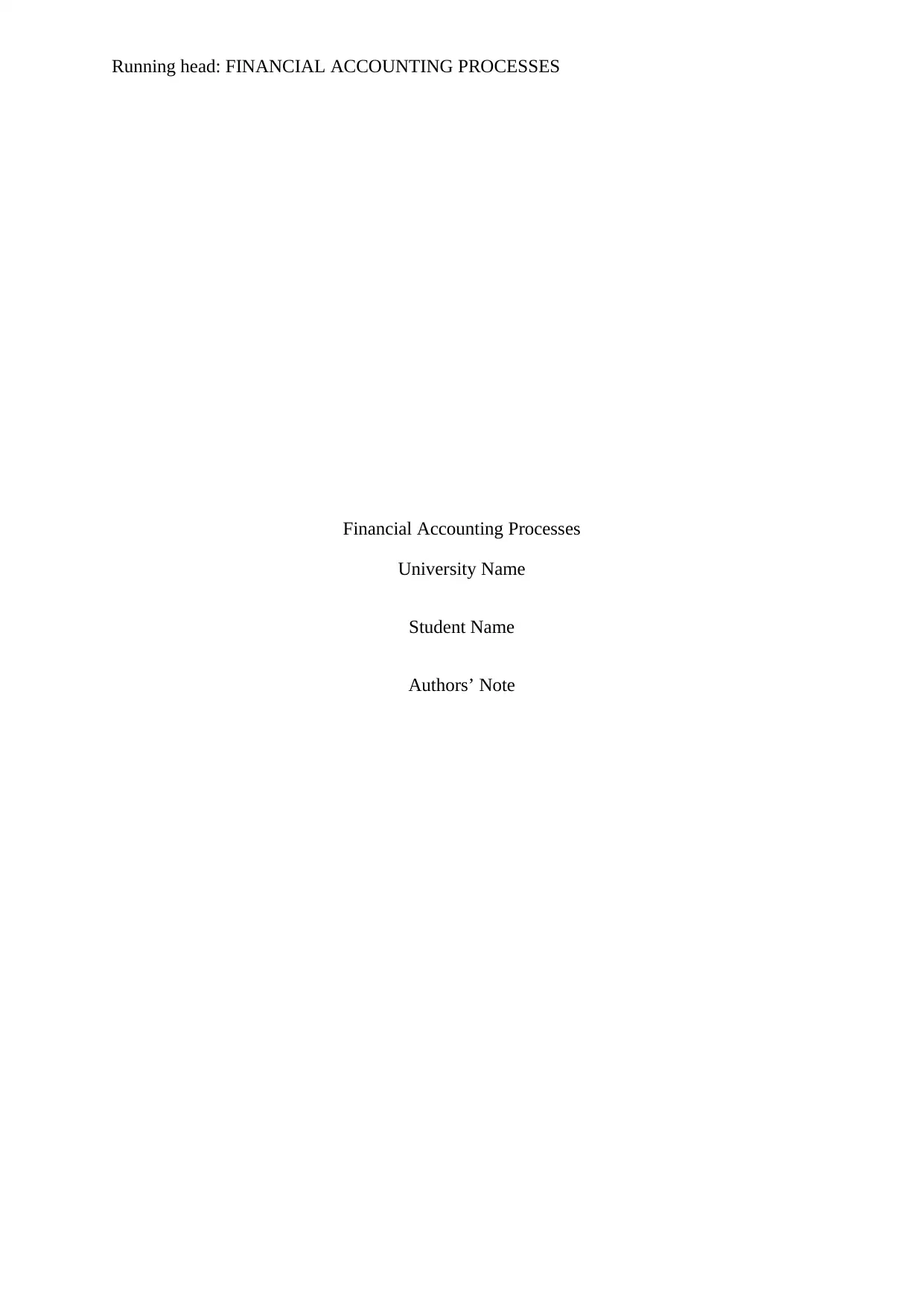
Running head: FINANCIAL ACCOUNTING PROCESSES
Financial Accounting Processes
University Name
Student Name
Authors’ Note
Financial Accounting Processes
University Name
Student Name
Authors’ Note
Paraphrase This Document
Need a fresh take? Get an instant paraphrase of this document with our AI Paraphraser
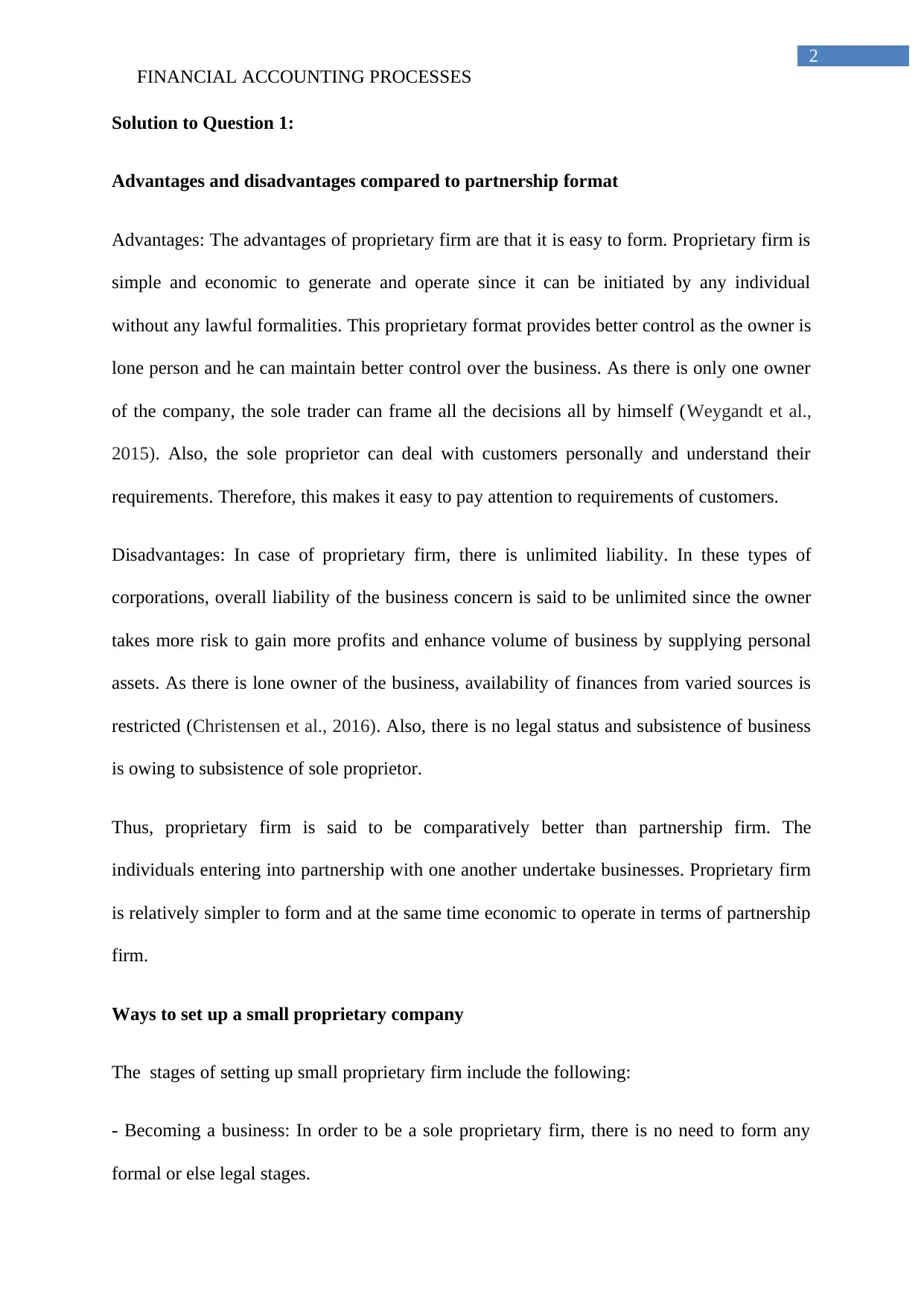
2
FINANCIAL ACCOUNTING PROCESSES
Solution to Question 1:
Advantages and disadvantages compared to partnership format
Advantages: The advantages of proprietary firm are that it is easy to form. Proprietary firm is
simple and economic to generate and operate since it can be initiated by any individual
without any lawful formalities. This proprietary format provides better control as the owner is
lone person and he can maintain better control over the business. As there is only one owner
of the company, the sole trader can frame all the decisions all by himself (Weygandt et al.,
2015). Also, the sole proprietor can deal with customers personally and understand their
requirements. Therefore, this makes it easy to pay attention to requirements of customers.
Disadvantages: In case of proprietary firm, there is unlimited liability. In these types of
corporations, overall liability of the business concern is said to be unlimited since the owner
takes more risk to gain more profits and enhance volume of business by supplying personal
assets. As there is lone owner of the business, availability of finances from varied sources is
restricted (Christensen et al., 2016). Also, there is no legal status and subsistence of business
is owing to subsistence of sole proprietor.
Thus, proprietary firm is said to be comparatively better than partnership firm. The
individuals entering into partnership with one another undertake businesses. Proprietary firm
is relatively simpler to form and at the same time economic to operate in terms of partnership
firm.
Ways to set up a small proprietary company
The stages of setting up small proprietary firm include the following:
- Becoming a business: In order to be a sole proprietary firm, there is no need to form any
formal or else legal stages.
FINANCIAL ACCOUNTING PROCESSES
Solution to Question 1:
Advantages and disadvantages compared to partnership format
Advantages: The advantages of proprietary firm are that it is easy to form. Proprietary firm is
simple and economic to generate and operate since it can be initiated by any individual
without any lawful formalities. This proprietary format provides better control as the owner is
lone person and he can maintain better control over the business. As there is only one owner
of the company, the sole trader can frame all the decisions all by himself (Weygandt et al.,
2015). Also, the sole proprietor can deal with customers personally and understand their
requirements. Therefore, this makes it easy to pay attention to requirements of customers.
Disadvantages: In case of proprietary firm, there is unlimited liability. In these types of
corporations, overall liability of the business concern is said to be unlimited since the owner
takes more risk to gain more profits and enhance volume of business by supplying personal
assets. As there is lone owner of the business, availability of finances from varied sources is
restricted (Christensen et al., 2016). Also, there is no legal status and subsistence of business
is owing to subsistence of sole proprietor.
Thus, proprietary firm is said to be comparatively better than partnership firm. The
individuals entering into partnership with one another undertake businesses. Proprietary firm
is relatively simpler to form and at the same time economic to operate in terms of partnership
firm.
Ways to set up a small proprietary company
The stages of setting up small proprietary firm include the following:
- Becoming a business: In order to be a sole proprietary firm, there is no need to form any
formal or else legal stages.
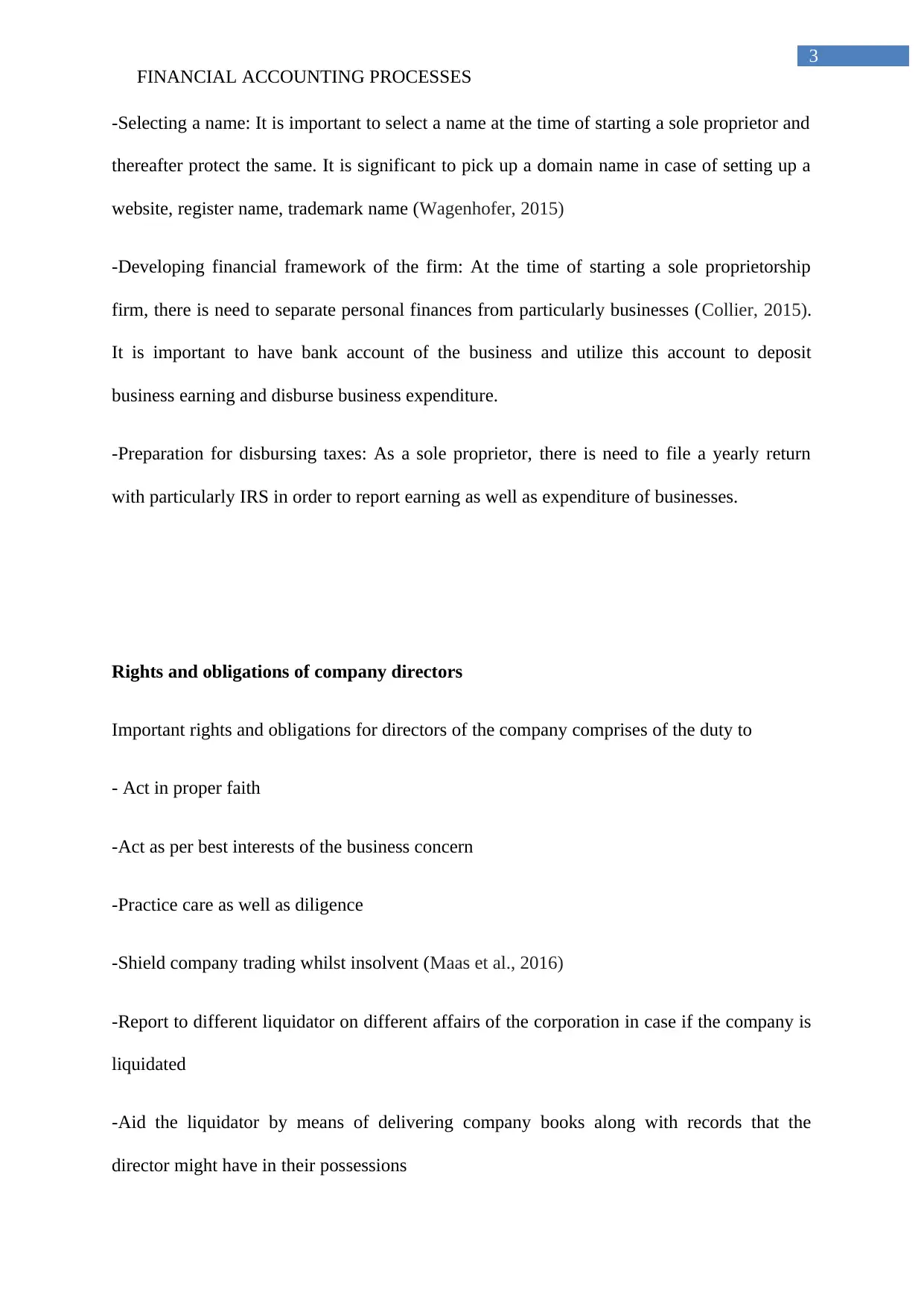
3
FINANCIAL ACCOUNTING PROCESSES
-Selecting a name: It is important to select a name at the time of starting a sole proprietor and
thereafter protect the same. It is significant to pick up a domain name in case of setting up a
website, register name, trademark name (Wagenhofer, 2015)
-Developing financial framework of the firm: At the time of starting a sole proprietorship
firm, there is need to separate personal finances from particularly businesses (Collier, 2015).
It is important to have bank account of the business and utilize this account to deposit
business earning and disburse business expenditure.
-Preparation for disbursing taxes: As a sole proprietor, there is need to file a yearly return
with particularly IRS in order to report earning as well as expenditure of businesses.
Rights and obligations of company directors
Important rights and obligations for directors of the company comprises of the duty to
- Act in proper faith
-Act as per best interests of the business concern
-Practice care as well as diligence
-Shield company trading whilst insolvent (Maas et al., 2016)
-Report to different liquidator on different affairs of the corporation in case if the company is
liquidated
-Aid the liquidator by means of delivering company books along with records that the
director might have in their possessions
FINANCIAL ACCOUNTING PROCESSES
-Selecting a name: It is important to select a name at the time of starting a sole proprietor and
thereafter protect the same. It is significant to pick up a domain name in case of setting up a
website, register name, trademark name (Wagenhofer, 2015)
-Developing financial framework of the firm: At the time of starting a sole proprietorship
firm, there is need to separate personal finances from particularly businesses (Collier, 2015).
It is important to have bank account of the business and utilize this account to deposit
business earning and disburse business expenditure.
-Preparation for disbursing taxes: As a sole proprietor, there is need to file a yearly return
with particularly IRS in order to report earning as well as expenditure of businesses.
Rights and obligations of company directors
Important rights and obligations for directors of the company comprises of the duty to
- Act in proper faith
-Act as per best interests of the business concern
-Practice care as well as diligence
-Shield company trading whilst insolvent (Maas et al., 2016)
-Report to different liquidator on different affairs of the corporation in case if the company is
liquidated
-Aid the liquidator by means of delivering company books along with records that the
director might have in their possessions
⊘ This is a preview!⊘
Do you want full access?
Subscribe today to unlock all pages.

Trusted by 1+ million students worldwide
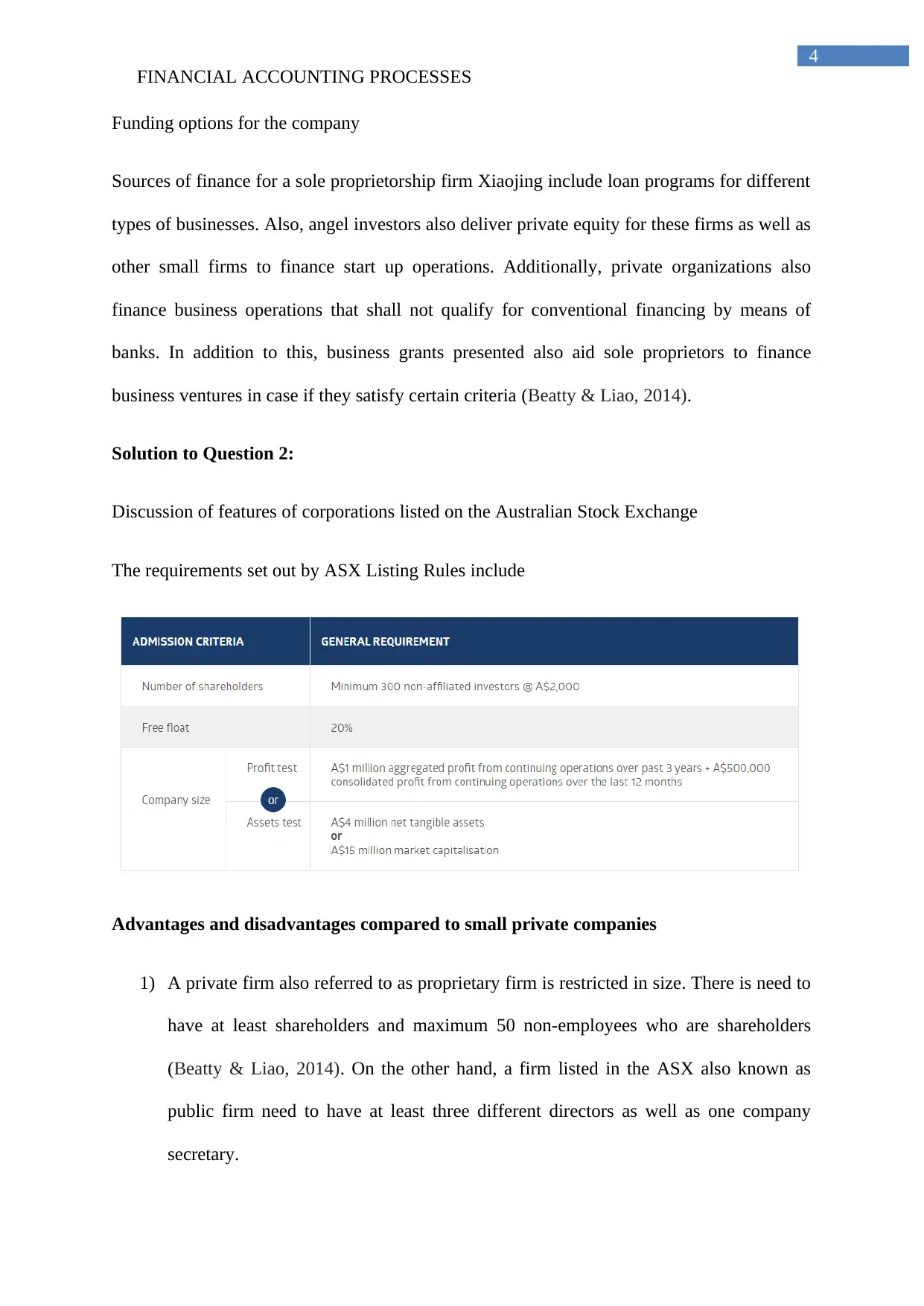
4
FINANCIAL ACCOUNTING PROCESSES
Funding options for the company
Sources of finance for a sole proprietorship firm Xiaojing include loan programs for different
types of businesses. Also, angel investors also deliver private equity for these firms as well as
other small firms to finance start up operations. Additionally, private organizations also
finance business operations that shall not qualify for conventional financing by means of
banks. In addition to this, business grants presented also aid sole proprietors to finance
business ventures in case if they satisfy certain criteria (Beatty & Liao, 2014).
Solution to Question 2:
Discussion of features of corporations listed on the Australian Stock Exchange
The requirements set out by ASX Listing Rules include
Advantages and disadvantages compared to small private companies
1) A private firm also referred to as proprietary firm is restricted in size. There is need to
have at least shareholders and maximum 50 non-employees who are shareholders
(Beatty & Liao, 2014). On the other hand, a firm listed in the ASX also known as
public firm need to have at least three different directors as well as one company
secretary.
FINANCIAL ACCOUNTING PROCESSES
Funding options for the company
Sources of finance for a sole proprietorship firm Xiaojing include loan programs for different
types of businesses. Also, angel investors also deliver private equity for these firms as well as
other small firms to finance start up operations. Additionally, private organizations also
finance business operations that shall not qualify for conventional financing by means of
banks. In addition to this, business grants presented also aid sole proprietors to finance
business ventures in case if they satisfy certain criteria (Beatty & Liao, 2014).
Solution to Question 2:
Discussion of features of corporations listed on the Australian Stock Exchange
The requirements set out by ASX Listing Rules include
Advantages and disadvantages compared to small private companies
1) A private firm also referred to as proprietary firm is restricted in size. There is need to
have at least shareholders and maximum 50 non-employees who are shareholders
(Beatty & Liao, 2014). On the other hand, a firm listed in the ASX also known as
public firm need to have at least three different directors as well as one company
secretary.
Paraphrase This Document
Need a fresh take? Get an instant paraphrase of this document with our AI Paraphraser
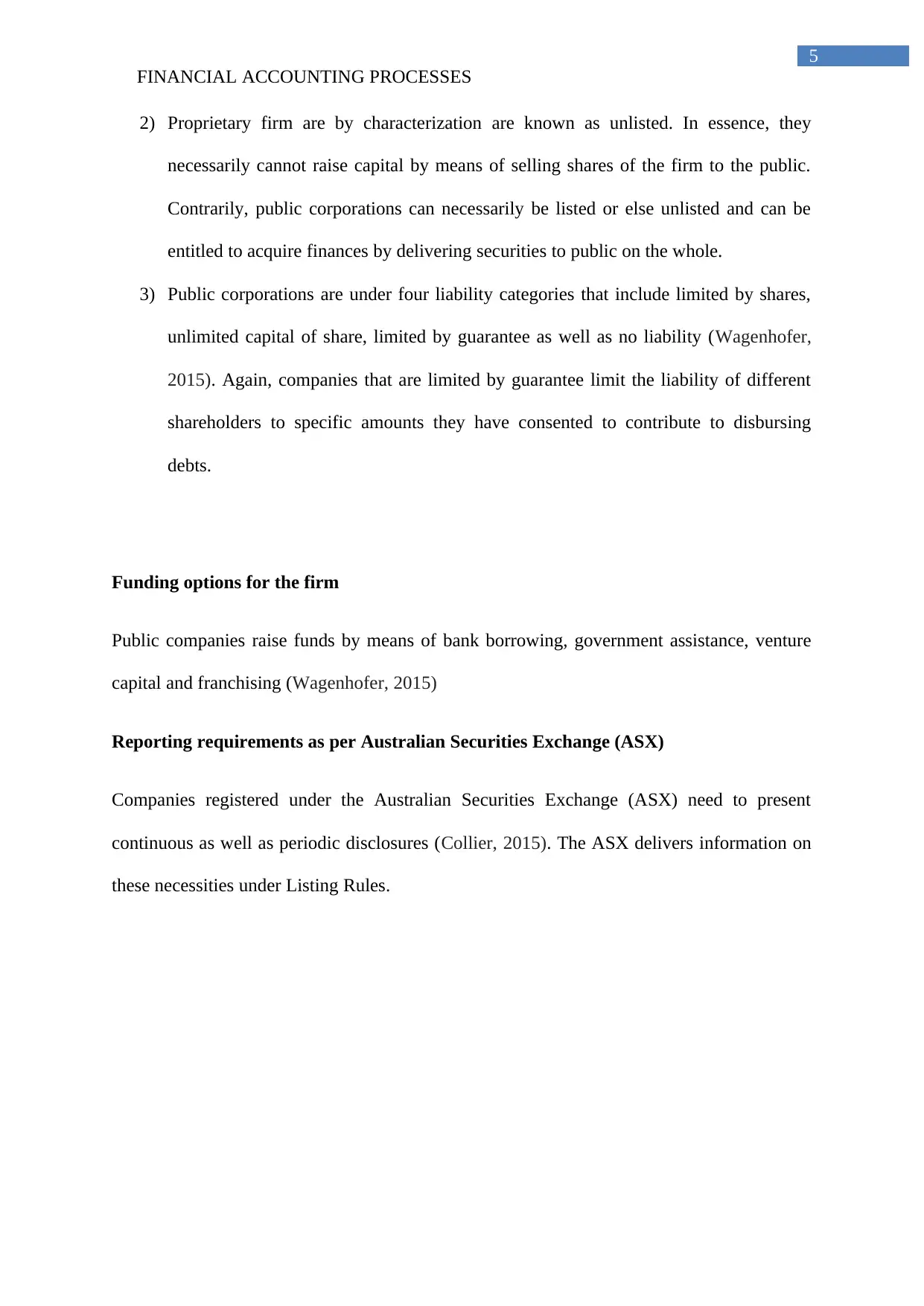
5
FINANCIAL ACCOUNTING PROCESSES
2) Proprietary firm are by characterization are known as unlisted. In essence, they
necessarily cannot raise capital by means of selling shares of the firm to the public.
Contrarily, public corporations can necessarily be listed or else unlisted and can be
entitled to acquire finances by delivering securities to public on the whole.
3) Public corporations are under four liability categories that include limited by shares,
unlimited capital of share, limited by guarantee as well as no liability (Wagenhofer,
2015). Again, companies that are limited by guarantee limit the liability of different
shareholders to specific amounts they have consented to contribute to disbursing
debts.
Funding options for the firm
Public companies raise funds by means of bank borrowing, government assistance, venture
capital and franchising (Wagenhofer, 2015)
Reporting requirements as per Australian Securities Exchange (ASX)
Companies registered under the Australian Securities Exchange (ASX) need to present
continuous as well as periodic disclosures (Collier, 2015). The ASX delivers information on
these necessities under Listing Rules.
FINANCIAL ACCOUNTING PROCESSES
2) Proprietary firm are by characterization are known as unlisted. In essence, they
necessarily cannot raise capital by means of selling shares of the firm to the public.
Contrarily, public corporations can necessarily be listed or else unlisted and can be
entitled to acquire finances by delivering securities to public on the whole.
3) Public corporations are under four liability categories that include limited by shares,
unlimited capital of share, limited by guarantee as well as no liability (Wagenhofer,
2015). Again, companies that are limited by guarantee limit the liability of different
shareholders to specific amounts they have consented to contribute to disbursing
debts.
Funding options for the firm
Public companies raise funds by means of bank borrowing, government assistance, venture
capital and franchising (Wagenhofer, 2015)
Reporting requirements as per Australian Securities Exchange (ASX)
Companies registered under the Australian Securities Exchange (ASX) need to present
continuous as well as periodic disclosures (Collier, 2015). The ASX delivers information on
these necessities under Listing Rules.
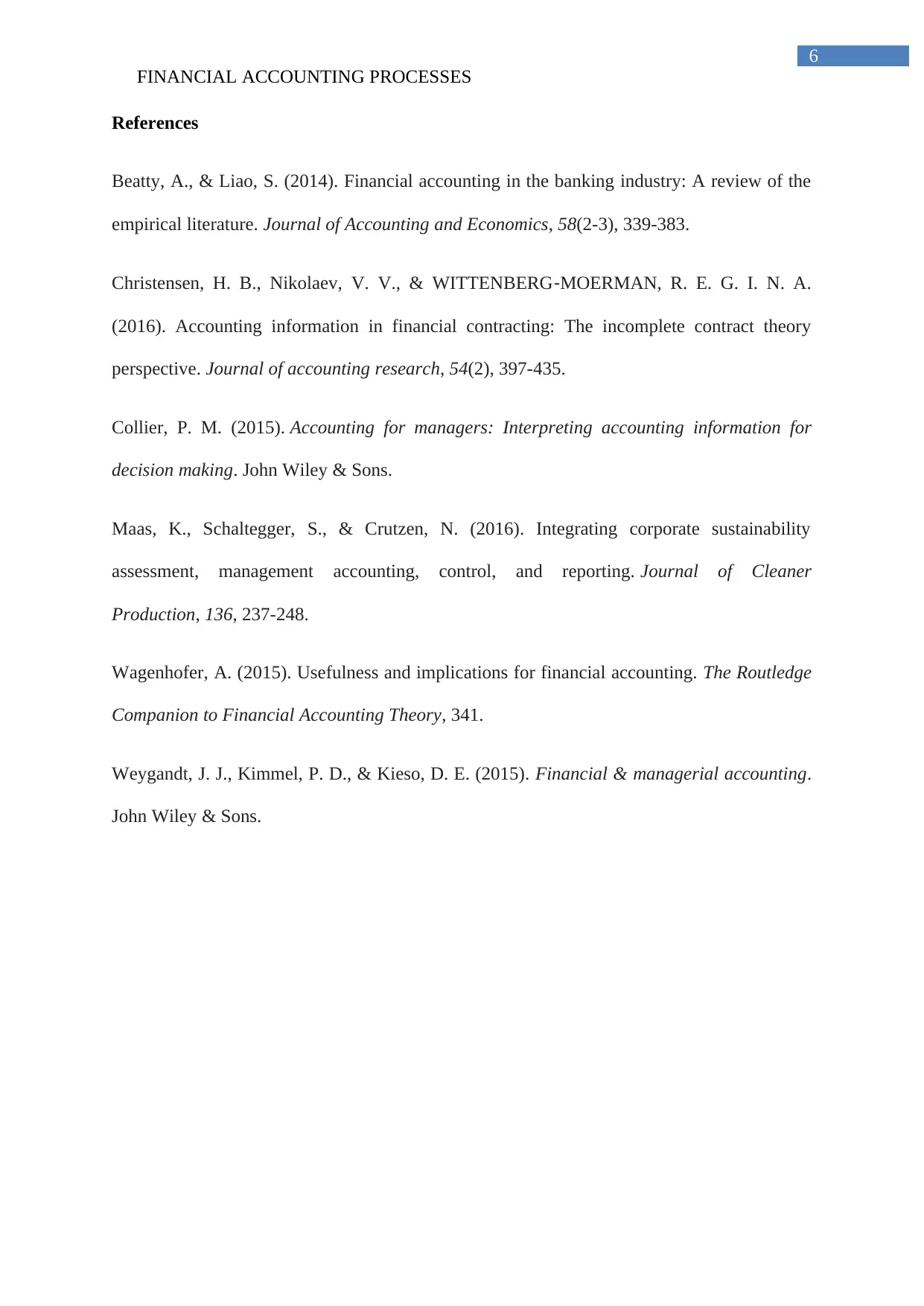
6
FINANCIAL ACCOUNTING PROCESSES
References
Beatty, A., & Liao, S. (2014). Financial accounting in the banking industry: A review of the
empirical literature. Journal of Accounting and Economics, 58(2-3), 339-383.
Christensen, H. B., Nikolaev, V. V., & WITTENBERG‐MOERMAN, R. E. G. I. N. A.
(2016). Accounting information in financial contracting: The incomplete contract theory
perspective. Journal of accounting research, 54(2), 397-435.
Collier, P. M. (2015). Accounting for managers: Interpreting accounting information for
decision making. John Wiley & Sons.
Maas, K., Schaltegger, S., & Crutzen, N. (2016). Integrating corporate sustainability
assessment, management accounting, control, and reporting. Journal of Cleaner
Production, 136, 237-248.
Wagenhofer, A. (2015). Usefulness and implications for financial accounting. The Routledge
Companion to Financial Accounting Theory, 341.
Weygandt, J. J., Kimmel, P. D., & Kieso, D. E. (2015). Financial & managerial accounting.
John Wiley & Sons.
FINANCIAL ACCOUNTING PROCESSES
References
Beatty, A., & Liao, S. (2014). Financial accounting in the banking industry: A review of the
empirical literature. Journal of Accounting and Economics, 58(2-3), 339-383.
Christensen, H. B., Nikolaev, V. V., & WITTENBERG‐MOERMAN, R. E. G. I. N. A.
(2016). Accounting information in financial contracting: The incomplete contract theory
perspective. Journal of accounting research, 54(2), 397-435.
Collier, P. M. (2015). Accounting for managers: Interpreting accounting information for
decision making. John Wiley & Sons.
Maas, K., Schaltegger, S., & Crutzen, N. (2016). Integrating corporate sustainability
assessment, management accounting, control, and reporting. Journal of Cleaner
Production, 136, 237-248.
Wagenhofer, A. (2015). Usefulness and implications for financial accounting. The Routledge
Companion to Financial Accounting Theory, 341.
Weygandt, J. J., Kimmel, P. D., & Kieso, D. E. (2015). Financial & managerial accounting.
John Wiley & Sons.
⊘ This is a preview!⊘
Do you want full access?
Subscribe today to unlock all pages.

Trusted by 1+ million students worldwide
1 out of 6
Related Documents
Your All-in-One AI-Powered Toolkit for Academic Success.
+13062052269
info@desklib.com
Available 24*7 on WhatsApp / Email
![[object Object]](/_next/static/media/star-bottom.7253800d.svg)
Unlock your academic potential
Copyright © 2020–2025 A2Z Services. All Rights Reserved. Developed and managed by ZUCOL.





